Vineyard
-
What is Grape Veraison
July 21, 2022 12:34
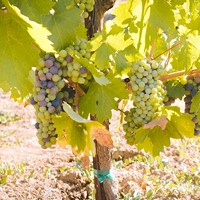
UNDERSTANDING GRAPE VERAISON
Each summer, grapes begin to change color in our Dry Creek Valley zinfandel vineyards. Grape veraison is the beginning of ripening, when red grapes change from green to purple colors. Veraison usually begins in July during moderate weather years, but in cooler vintages, zinfandel grapes don’t start changing color until late July, even early August at times. During ideal weather conditions, the time from coloration to harvest is typically about forty-five days.
There’s much more to grape veraison than the fascinating color change we can see with our eyes. To allow vines to focus all their energy into the existing clusters hanging on their shoots, the grapes cease growing during this period of their lifecycle. This allows sugars to increase and acids to decrease.
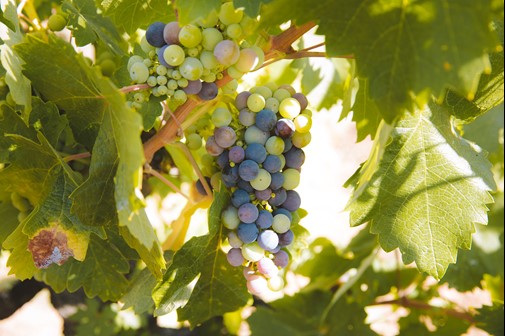
WHY EVEN GRAPE VERAISON IS IMPORTANT
Winemakers want the grape clusters to go through veraison quickly, because the uniformity of coloring within the clusters equals uniform flavors at harvest time. Being able to harvest uniformly ripened grapes is one of the keys to making a velvety, balanced Pedroncelli Zinfandel. If some grapes in the clusters are under-ripe, some perfect and some overripe, the finished wine will express some combination of too dry, too fruity and even too hot or high in alcohol. Only uniformly colored zinfandel grapes can make a balanced, smooth wine.
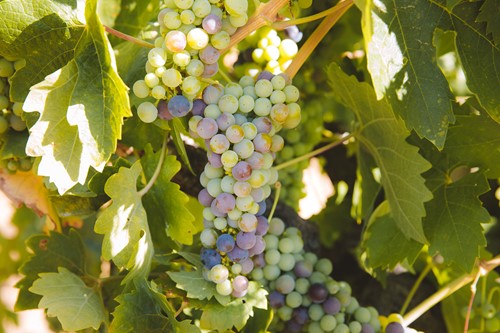
ADDRESSING UNEVEN COLORS DURING VERAISON
The warmer the weather, the more likely the grapes will change colors swiftly and uniformly. So, what does a winemaker do when the grapes change color unevenly? At Pedroncelli, we wait until veraison has taken 80% effect on our zinfandel vineyards, then we’ll start to trim off the “wings” and clusters that are still green. This sacrifice ensures the remaining grapes on the vine develop consistent flavors which will translate later into the wine.
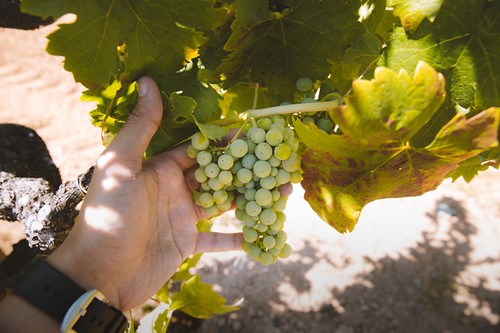
Here's an example of a cluster with a “wing.” A wing is a small bunch that shares the same shoot as a fuller cluster.
During ideal growing seasons, moderately warm temperatures help veraison happen at a perfect pace. Zinfandel, Cabernet Sauvignon and Merlot grapes start changing color in Dry Creek Valley during July and August, depending on when vineyard pruning occurred and the microclimate of each vineyard. In an average year, Pedroncelli’s Dry Creek vineyards complete veraison over two to three weeks.
DO GRAPES CHANGE COLOR AT DIFFERENT TIMES?
Different red grapes varieties go through veraison at different times. Just like during harvest, we don’t always pick the same grapes at the same time. It is spread out over several weeks. If Zinfandel is in veraison now, then we’ll be picking about the second week of September. Cabernet Sauvignon on the other hand has not even started veraison and we’ll expect to pick these grapes at the end of September or beginning of October. It always depends on the weather between now and then too.
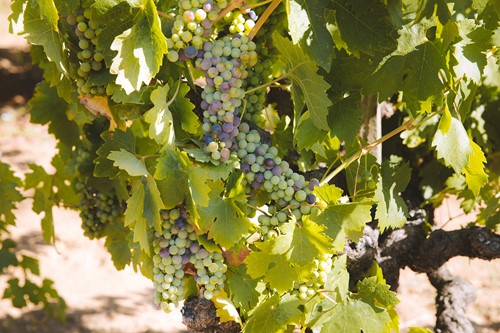
Follow us on social media to stay up to date with our harvest season.
-
Follow the Vineyard: Winter Among the Vines
December 1, 2020 11:23

My monthly chat with Mitch Blakeley on following the vines' progress and includes notes about the vineyard as it moves into winter dormancy and what we do in the transitional time between seasons.
Our Mother Clone vines are in their final fall color glory as I write this. In fact they are being pruned because the cold weather hit just a couple of weeks ago signaling to the vine it was time for the long winter’s nap.
There are still a few things to do in and around the vineyard as well as in the cellar. Mitch Blakeley, Vineyard Assistant, and I caught up the other day.
We had a big project along the creek, where we have the 50 acres of Bordeaux varieties planted. With some heavy rains a couple of years ago it brought down large trees and bushes which began to divert the water into the banks along the vineyard avenue causing heavy erosion. There is also an issue with debris down a little further doing the same thing with so much brush and it was changing the direction of the creek. The vineyard crew spent a good part of October and November cleaning it up, quite a large project. But it is good to have it done so the water no longer eats away at the bank.
In the vineyard we started a little earlier than we wanted to prune. What happened is the freeze came and no wind. This began the shut off in the vine signaling dormancy and the leaves and canopy were just hanging there. With the leaves blocking the end of the cane it takes longer to prune because you want to trim at the right cut-the place where the next year’s crop begins. This is where the two buds at the base of the year old cane are located. We started in the Zinfandel; by end of week they’ll be close to halfway through half of the acreage. A good start to the 100 acres that needs to be pruned. The Right Cut.
Overall the next couple of months are pretty quiet. Some of the vineyard crew works in the cellar too-special labeling projects and club shipments. Others work on equipment to get it ready for chopping-and keep other tractors etc in working condition.
In getting ready for spring we typically begin to seed a cover crop (bell beans) now but we have found foreign grasses and weeds in our vineyard and are trying to eradicate them so we will be skipping this year in order to gain some control of the weeds mixed into the cover crop. I’ll be taking a webinar on soil amendments to see if there are other ways of bringing nutrition to the vineyard and other insights to spring time applications. We are also in contact with the irrigation company to set up tools to monitor vines using moisture and these tools will help us know when best to irrigate and how much in order to made sure we aren’t over watering or over using such a precious resource.
After we talked I thought about his comment that things are pretty quiet around here. Once I wrote up the notes it sounds like there is a lot more going on than Mitch let on-but that is pretty much the way we operate around here.
-
Follow the Vineyard: Bloom
May 21, 2020 08:24

Following the progress at our estate vineyards helps keep things in perspective. While we all shelter in place (hopefully not for much longer) the vines are happily making their way toward vintage 2020. I visited with Mitch Blakeley, fourth generation family member, to check in and get his perspective about what it going on out in the vineyard.
We farm 115 acres of vineyard between the Mother Clone, Home Ranch, Three Vineyards, Wisdom, Alto Vineyards, Bench Vineyards, East Side Vineyards and Bushnell Vineyard with 11 varietals planted between all of them. Some of these are small blocks while other encompass 30 or so acres between them. It all adds up to quite a bit of work for Lance Blakeley, Vineyard Manager, and Manuel Diaz, Vineyard Foreman along with Mitch who is not only in the vineyard he also led the certification process for sustainability in both the vineyard and winery.
Here are some in depth details about what is going on right now as we follow the vineyard this month in the bloom phase. Bloom or flowering (I’ll use the terms interchangeably) takes place about 6 weeks after budbreak, the first growth in the vine since winter dormancy which typically takes place in March. The leaves and shoots lengthen during the next month or so and small ‘bunches’ form. Bloom is when the future bunch of grapes breaks into tiny flowers-the smell is heavenly!-with crop set following in the next few weeks.
Follow the vineyard as I recap Mitch's comments on what is going on this month: The rain, while not as heavy compared to 2019’s six inches, actually mirrors almost to the day the time it rained the third week of May in last year. Over a week or so about an inch and a half of rain fell this year. What did this do to the vines? While April was warm and a few days in early May were over 90 degrees it became cold and rainy, slowing bloom time down. One of the benefits of receiving rains in the spring: it saves water. Mitch predicted they would be able to skip a full cycle of operating the drip irrigation system in the vineyards. Vines rely on interspersed drip irrigation during the dry months of summer and late rain helps delay the initial cycle of watering.
Flowering in some of the varietals, like Cabernet Franc, went quickly and is almost complete. Slow bloomers like Sauvignon Blanc and Cabernet Sauvignon were just beginning. Zinfandel was at about 40% and other grapes like Sangiovese and Petite Sirah were somewhere in between. Rain will sometimes knock off some of the flowering which in turn might lower the production of fruit. It remains to be seen if this has happened in our vineyards-crop set takes place in June so we will know more by the end of next month.
The vineyard crew continues with tractor work, weed maintenance and suckering, which is the most important during this time because a vine will push lots of growth in the spring. If not taken care of by stripping off the multiple offshoots this will overburden the vine and eventually would inhibit getting a ripe crop if allowed to continue. Suckering takes place over the whole vine along the arms and at the base. Some of the wood is softer in varietals like Merlot and Sauvignon Blanc-so they will be suckered next but right now the crew is working on the Zinfandel and Cabernet as the vine trunks and arms are harder wood and harder to sucker as things begin to dry out. We are expecting 90 degree weather the last week of May and this accelerates the conditions so the crew is busy now in these vineyards in order to get ahead.
Thanks Mitch for the update. We've farmed for four generations and have seen many different scenarios throughout those years. This vintage will go in the books as one of the most unusual because of COVID19. As farmers we look forward to the next phase of growth because the vineyard naturally follows the tilt of the sun, the ebb and flow of weather and creates something new each year.
-
Heat & the Vine
June 28, 2017 16:40

What happens in the vineyard when summer hasn’t even begun and we have one of the hottest days on record? On Sunday June 18th the temperature hit 110 degrees in our little corner of Dry Creek Valley. The days that followed were not much better and the mercury wavered between the mid 90s to over 100 degrees again on Thursday. This pre-summer heat wave definitely had my attention.
I was curious-what does happen to the vines as it gets unseasonably hot? It isn’t the first time the month of June has seen this heat and it does some good to know the following week we had our fog back in the evenings with pleasant temps in the low 80s. I asked our Vineyard Manager Lance Blakeley to explain a few things to me. How does he prepare? What happens to the fruit? Was it a good time to have a heat wave?
First of all he was ready for the heat-farmers are always weather watchers and he and the crew prepared the vineyard for what was coming by drip irrigating the ranches, which totals 105 acres. This in and of itself helped the vines to survive the brutal heat which hit on the 18th. The fruit was protected by the canopy of canes and leaves. There was little to no scorching of the green berries. If there was a good time to have a heat wave this was it-if it had occurred during bloom time we would have a more drastic story to tell.
I learned something too. The leaves actually move to cover either the stem or the fruit, whichever is in danger of scorching. One way to test if the vine is keeping cool is to feel the leaves-if they are cool then they are safe. If they are warm to the touch then they need some help as they’ll begin to wilt and become overwhelmed by the heat. Kind of like people-we wilt when it becomes too hot and just want a cool drink of water. The good news is, with temperatures rising in the first week of July, the vineyards are acclimated to the heat by this first wave. Here's to the vines and the hard working crew who takes care of them with a splash of Rosé of Zinfandel in my Dino!
Categories
- COVID
- Follow the Vineyard
- Note from Home
- PairItWithPed
- Pandemic
- pedroncelli
- Port
- Postcards from Home
- Pruning
- Seasons in The Cellar
- Tasting Room
- Thanksgiving
- Vintage Notes
- Winemaking
- Women's History Month
Recent posts
-
91 Years Later
-
Come Over October: It's About Community
-
Come Over October
-
A Legacy Continues!
-
Everything Old is New Again
Popular tags
- cooking with wine
- Rosé
- Estate Vineyard
- family
- Seasons in The Cellar
- Barrels
- OpenThatBottleNight
- Crop set
- Heat wave
- Easter
- Courage Zinfandel
- Four Grapes Port
- American Oak
- Habit
- Holding steady
- Cookies
- 1974 Cabernet Sauvignon
- Harvest 2022
- PairitwithPed
- Cabernet Sauvignon
- COVID19
- Recipes
- Library Wine
- Merlot
- French Oak
- Sonoma County
- Dry Creek Valley
- Finding Your Roots
- Lake Sonoma
- Oak
- Mother Clone
- COVID Coffee Chat
- Homecooking
- food and wine
- note from home
- Reserve
- Bushnell Vineyard
- Down to Earth
- Sauvignon Blanc
- cheese
- Pandemic
- Pruning
- Schotzki
- Anniversary
- Cellar Master
- Block 007 Cabernet Sauvignon
- Pedroncelli
- newsletter
- Pantry
- Follow the Vineyard









